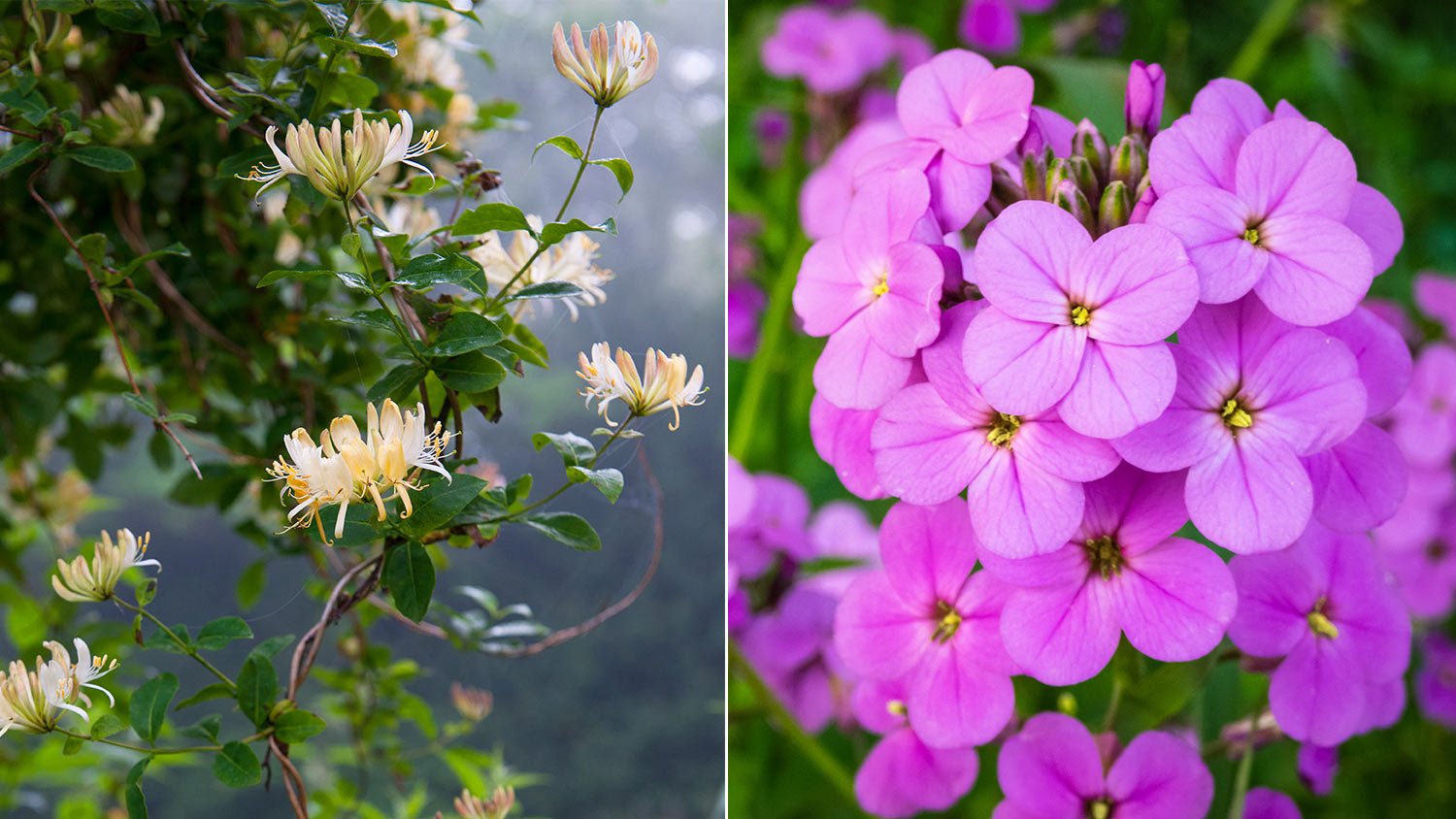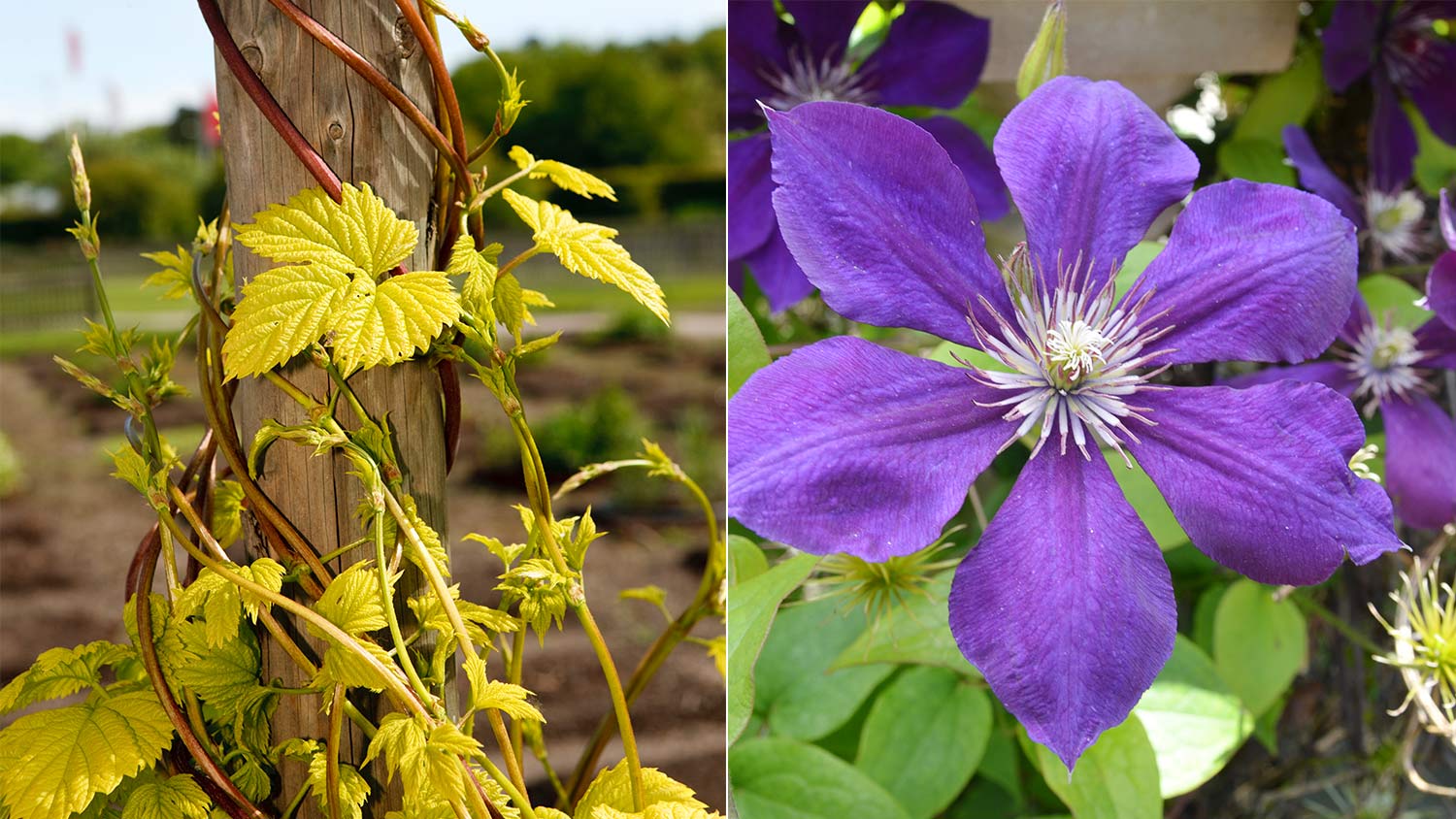
Landscape curbing can really improve the look of a yard, but at what cost? Find out how much it costs and the different ways you can do it
Companion plants prove that sometimes things are better in pairs


The right combination of climbing plants can help give your home’s exterior a springtime refresh—especially as they start blooming on a garden trellis or trailing down a hanging basket. How do you find the perfect match? Climbing plant combinations are a delicate balance of texture, color, smell, season, and temperament.
In general, your companion plants should be able to tolerate the same conditions and work together. Think of perennials that mask annual die-back or vines with staggered blooming seasons. A local gardener or landscape designer in your area will be able to tell what works best in your backyard, but these amazing climbing plant combinations can help spark some inspiration.

Clematis—which is part of the buttercup family—is a broad genus of climbing perennial herbs that produce colorful blooms in shades of red, purple, pink, and blue. They have a reputation for growing beautifully alongside climbing roses, especially because roses have a relatively short flowering season and their sturdy stems give clematis a surface to climb.
Pick a species that won’t overwhelm the roses with robust growth. Plants in the Jackmanii group tend to do best. This includes Clematis ‘Comtesse de Bouchard,’ clematis ‘Victoria’ (Clematis viticella), and Clematis ‘star of India’—but if your roses are pastel hues, Clematis jackmanii is a clear winner. The rich purple blooms create a bold contrast.

If you’re looking for garden fence ideas, bring honeysuckle to the top of your list. This climbing plant does best when grown on a fence or trellis. Nonetheless, a gorgeous landscape is about more than what meets the eye—it’s also about what meets the nose.
The main draw of honeysuckle is the sweet-smelling blossoms in shades of yellow, orange, and red. They emit a heavy, almost fruity, smell that’s well-paired with sweet rocket, a tall-growing biennial plant with pink or white blooms.
Both plants emit the most fragrance in the evening, making them a lovely plant combination for summer nights. Though not a climber itself, sweet rocket will fill in the lower part of your garden, while honeysuckle can give your space some height.

Both golden hop and Clematis ‘polish spirit’ are perennials—but this climbing plant combination factors in flowering. Clematis generally only blooms from midsummer to early autumn, but golden hop has gorgeous foliage throughout spring, summer, and fall. When flowers finally appear, golden hop’s lime green leaves offer a contrasting backdrop that makes the stunning purple petals look even brighter.

If plants had personalities, you could say black-eyed Susan (Rudbeckia hirta) is laid-back. As long as you don’t disturb the roots, give it adequate water, and place it in adequate sunlight, it should last the whole season. In warm-weather climates, the vine may even act as a short-lived perennial—though it can border on invasive because it rigorously self-seeds.
With bright yellow blooms, black-eyed Susan perfectly pairs with morning glory, especially if you choose a variety with blue or purple blooms (the colors opposite on the color wheel). This duo grows beautifully in full sunlight and will make great patio plants. Potting black-eyed Susan and putting it in a pavement-heavy area where it can’t self-seed can help keep it under control.

Looking to grow some climbing veggies? Get ready to add to your list of edible landscape hacks. Pole beans and cucumbers are among the best climbing plant combinations to add to your edible greenery.
These companion plants actually help each other grow. Beans have a root system that boosts nitrogen levels in the soil, essentially self-fertilizing. Unfortunately, they’re also susceptible to over-fertilization. If they absorb too much nitrogen, you’ll have a large bean plant with a tiny harvest.
Cucumbers are heavy feeders and need a lot of nutrients. They’ll help balance out nitrogen levels for your beans. With proper care, these plants should have a bountiful harvest.

Climbing hydrangeas and Virginia creeper (Parthenocissus quinquefolia) get a bad wrap for being vigorous growers. They don’t always play nice with other plants—snuffing out those that are more delicate—but together, they help each other chill out. It just depends on the variety.
Both moonlight hydrangea and Chinese Virginia creeper are self-clinging. That means they can climb on their own using aerial roots, but hydrangea usually needs support as it matures due to its substantial vines. Chinese Virginia creeper—a more laid-back version of the original Virginia creeper—is up to the task. It’s a strong enough grower to support hydrangea but not so much that it suffocates the plant.

The wisteria and Clematis ‘Rubens’ (Clematis montana ‘Rubens’) pairing is another excellent garden trellis idea. These two climbing plants are a perfect contrast—with clematis offering small, pink blooms and wisteria producing larger purple blooms.
They generally grow together, blooming in the spring and early summer (depending on your USDA Zone). In fact, clematis can fill out your wisteria plant if areas become sparse as your plant matures. When the season is over, wisteria will leave behind velvety pods that look like beans, and clematis will offer whimsical, wispy seed heads that are fluffier than your best dandelion.
Remember that climbing plant combinations aren’t a one-size-fits-all solution. Even when intertwined, each climbing plant has unique pruning needs. Some vines can damage masonry and may even be invasive in certain USDA Plant Hardiness Zones.
From average costs to expert advice, get all the answers you need to get your job done.

Landscape curbing can really improve the look of a yard, but at what cost? Find out how much it costs and the different ways you can do it

Leveling your yard can help with drainage and prevent damage to your home. Learn the cost to level a yard in Columbus, OH, and what factors can affect the price.

The cost to remove a boulder depends on the size, location, and equipment needed. Learn the average boulder removal cost and how to save money on removal.

There are reasons to grade or slope your yard beyond aesthetics—drainage is the main one. Read on and learn how to have an informed discussion with your pro.

Do you tip landscapers? Talking about tipping is often seen as a taboo, but there are a lot of nuances to getting the numbers right. This guide can help.

Whether you’re updating your yard or moving into a new home, these tips will help you make sure your landscaping tactics around your house prevent water.